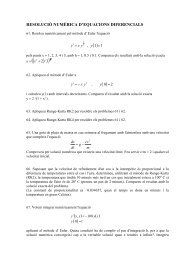Universitat de - Departament d'Astronomia i Meteorologia ...
Universitat de - Departament d'Astronomia i Meteorologia ...
Universitat de - Departament d'Astronomia i Meteorologia ...
Create successful ePaper yourself
Turn your PDF publications into a flip-book with our unique Google optimized e-Paper software.
110 Chapter 3. LS 5039 as a runaway microquasar<br />
(1999):<br />
<br />
vsys<br />
km s −1<br />
1<br />
−<br />
∆ M MO Pre−circ<br />
= 213<br />
M⊙ M⊙ day<br />
3 MX + MO<br />
M⊙<br />
− 5<br />
3<br />
. (3.4)<br />
Assuming that MO = 40 M⊙ and Pre−circ = 3 days we can find two minimum values<br />
of vsys <strong>de</strong>pending on the adopted mass for the compact object. For MX = 1.4 M⊙,<br />
and hence ∆ M > 17 M⊙, we find vsys 200 km s −1 . Similarly, for MX = 9 M⊙,<br />
and hence ∆ M > 20 M⊙, we find vsys 180 km s −1 . Our measured recoil velocity<br />
is vsys 150 ± 20 km s −1 , which would be perfectly reached in the SN explosion<br />
scenario, as we have just seen. In fact, the measured value is a little bit lower than<br />
the computed ones, which could indicate that part of the eccentricity of the system<br />
was reached thanks to a kick in an asymmetric SN explosion. However, we must<br />
be cautious with the use of the value for vsys obtained after Eq. 3.4, because some<br />
effects have been ignored, as pointed out by Nelemans et al. (1999), and also the<br />
errors in e and Pre−circ could reduce the computed values. Hence, we can say that<br />
both, the high eccentricity measured by McSwain et al. (2001), and the high space<br />
velocity reported here, are perfectly compatible, within errors, with a symmetric<br />
SN explosion scenario. In other words, the actual eccentricity of the system is<br />
naturally explained with the mass loss necessary to explain the measured space<br />
(recoil) velocity of LS 5039. We note that McSwain & Gies (2002) have recently<br />
arrived to very similar conclusions using our proper motions.<br />
Another common mechanism referred to produce runaway stars is based on dy-<br />
namical ejection from young open clusters. Numerical simulations (Kiseleva et al.<br />
1998) show that it can explain some mo<strong>de</strong>rately high-velocity stars observed in the<br />
Galactic disk, but only about 1% of the stars would be ejected with velocities higher<br />
than 30 km s −1 . Hence, it seems difficult to explain the high observed velocity of<br />
LS 5039 as a result of such a mechanism.<br />
It is interesting to note that, contrary to other HMXB with low orbital peri-<br />
ods, LS 5039 is still in the circularization process. Using the actual value of P , a<br />
typical value of R = 10.3 R⊙ for the radius of the O6.5V star, and different for-<br />
malisms (Claret et al. 1995; Claret & Cunha 1997) we obtain typical circularization<br />
timescales of the or<strong>de</strong>r of (0.5 – 5) × 10 5 yr. These values are compatible with the<br />
system being still in the circularization process, since its formation just in the galac-<br />
tic midplane would take 5 × 10 5 yr to bring it to the actual position according to<br />
the integration of its trajectory.






